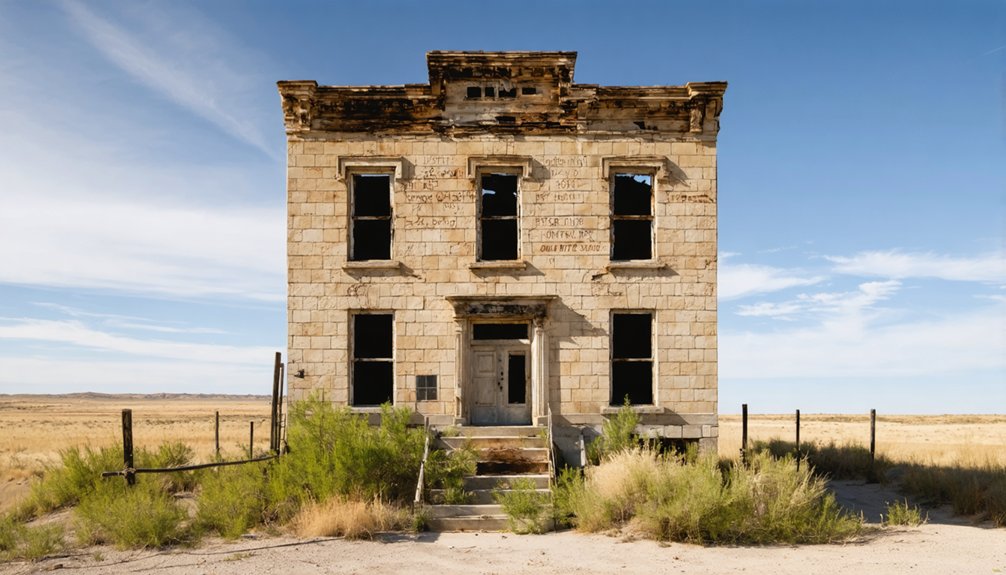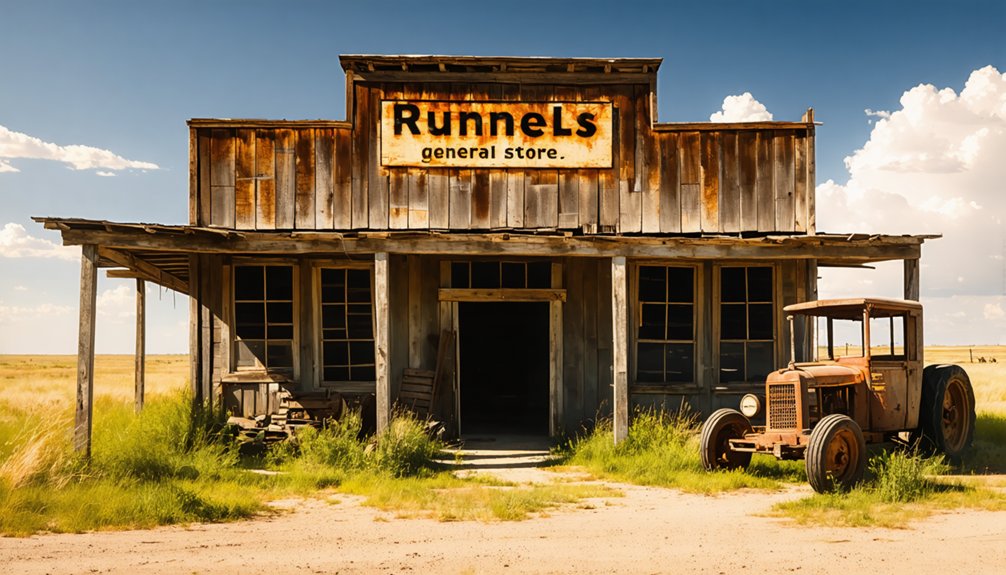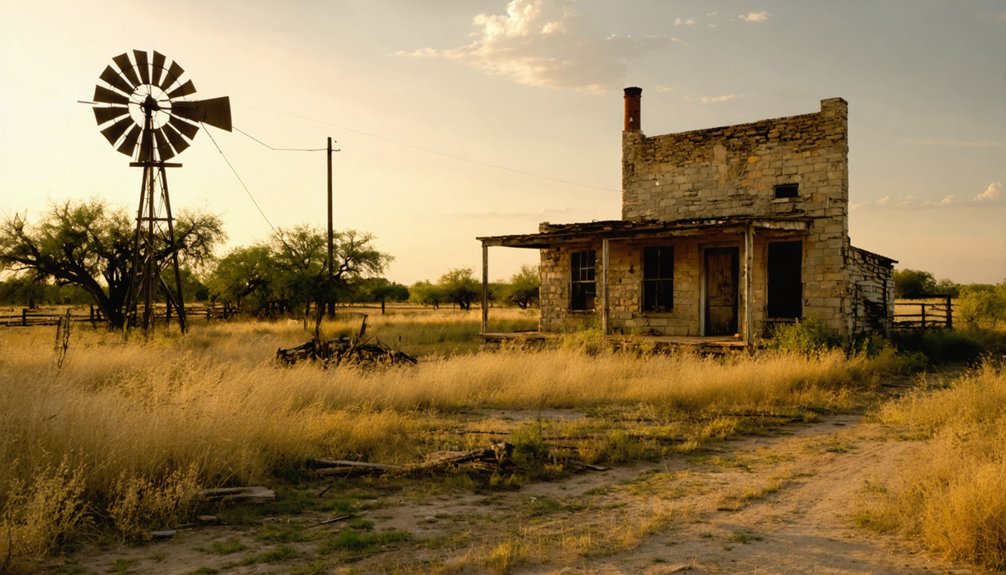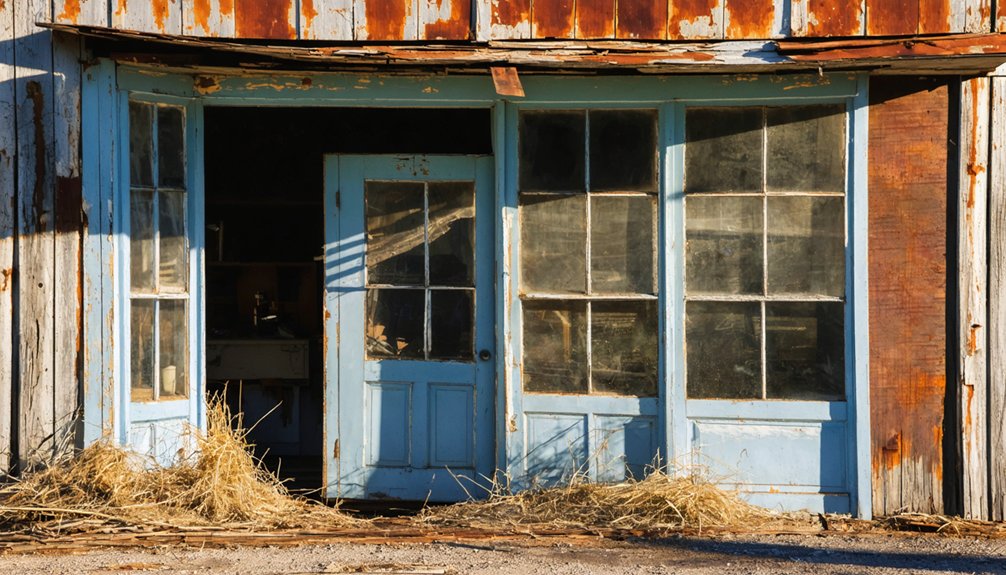You’ll find Runnels City was established as the first county seat of Runnels County, Texas in 1880. The town emerged from earlier settlements that faced Native American conflicts, with Fort Chadbourne providing protection until 1861. When the Gulf, Colorado and Santa Fe Railway chose Ballinger as its western terminus in 1886, Runnels City’s residents relocated there for free lots. By 1888, the abandoned site had become a ghost town, though its cemetery and a 1936 granite marker preserve its memory.
Key Takeaways
- Runnels City served as the original county seat of Runnels County in 1880 but was abandoned after Ballinger became the new county seat.
- The Gulf, Colorado and Santa Fe Railway’s decision to make Ballinger its western terminus in 1886 led to Runnels City’s decline.
- Residents were offered free lots to relocate from Runnels City to Ballinger, causing a mass exodus from the original settlement.
- Today, only a cemetery and a 1936 granite Centennial marker remain as physical evidence of Runnels City’s existence.
- The former townsite has been converted to agricultural land, with no remaining structures from its brief period as county seat.
The Birth of a Frontier County Seat
While Texas was still experiencing frontier challenges in 1858, the state legislature officially created Runnels County from parts of Bexar and Travis counties, naming it after former Mississippi governor and Texas legislator Hiram G. Runnels.
The Texas legislature carved Runnels County from Bexar and Travis territories, honoring Hiram Runnels’s legacy as governor and lawmaker.
You’ll find that initial settlement proved difficult due to Indian hostilities, with Pickettville emerging as the first civilian outpost in 1862.
The area’s first permanent settlers were John W. Guest and his family, who endured frequent encounters with Native Americans and lost significant livestock.
As frontier challenges gradually diminished through military campaigns in the 1870s, you’d see an economic shift take hold. By 1880, the county’s organization became official, with four precincts established and the first slate of county officials elected.
The newly-formed Commissioners Court initially designated Walthall as a temporary county seat, but voters soon chose Runnels City for their permanent seat of government in April 1880, marking a vital step in the county’s development.
The region’s early protection against Native American raids was provided by Fort Chadbourne established in 1852.
Native American Heritage and Early Spanish Influence
You’ll find that the Jumano Indians, Runnels County’s first documented inhabitants, actively traded with Spanish expeditions in the mid-1650s before seeking Christianity through the establishment of San Clemente Mission in 1684.
Spanish missionaries employed harsh disciplinary measures against native peoples who resisted conversion efforts during this period.
By the early 1700s, the Apache had forced the Jumano from their lands, only to face displacement themselves when Comanche warriors seized control of the region in the mid-1700s.
The Comanches maintained their dominance over the area for roughly a century, effectively preventing permanent settlement until military interventions in the mid-1800s cleared the way for Anglo-American colonization. The establishment of Fort Chadbourne in 1852 provided crucial protection for settlers against Native American raids.
Jumano Trade Relations
Before their decline in the early 18th century, the Jumano people established extensive trade networks and alliances with more than 30 Native American groups across Texas, New Mexico, and northern Mexico.
You’ll find evidence of their sophisticated trading system in the diverse goods they exchanged, including squash, corn, cotton, buffalo hides, meat, shells, and cloth.
The Jumano alliances weren’t just about commerce – they served as strategic partnerships against Apache raids and other threats. Their leader Don Juan Sabeata represented multiple Jumano nations in negotiations with Spanish authorities.
These resourceful traders used dogs pulling travo sleds to transport their goods across vast distances.
Their welcoming attitude toward strangers helped them build lasting relationships beyond mere trade.
By the mid-18th century, disease and warfare contributed to their absorption into other tribes, including the Apache and Wichita peoples.
Spanish Mission Establishment
As Apache hostilities intensified in 1684, the San Clemente Mission emerged as the first Spanish mission east of the Pecos River, marking a pivotal moment in Texas colonial history.
You’ll find this two-story log structure was built at the junction of the Colorado and Concho Rivers, though its exact location remains debated between Ballinger and Millersview.
Despite mission challenges, thousands of Jumano Indians sought baptism during the mission’s brief six-week existence. The Franciscan friars managed this and other missions throughout Texas as part of their religious order’s commitment to spreading Christianity.
The Spanish missions established strict daily routines that included prayer, work, training, and religious celebrations to help convert native populations.
The Franciscan missionaries, led by Nicolás López, anticipated representatives from 48 Native American bands, highlighting strong indigenous alliances.
However, mounting Apache threats forced the mission’s abandonment by May 1, 1684.
While the physical structure didn’t endure, San Clemente’s establishment represented Spain’s early attempts to claim territory and convert Native populations through religious outposts.
Apache-Comanche Territorial Conflicts
While Spanish missionaries sought to establish a foothold in Texas during the late 1600s, a far more dramatic power struggle was unfolding between the Apache and Comanche tribes.
Comanche warfare tactics proved highly effective as they pushed south from the Great Plains, forcing Apache bands to retreat from their traditional territories in present-day New Mexico, Colorado, and Kansas. The Lords of Plains dominated the region through superior horsemanship and military might for over 150 years.
You’ll find that this conflict reshaped the region’s political landscape, as Apaches formed alliances with Spanish authorities to counter Comanche dominance. The Comanche raids into Mexico would later become notorious, with warriors traveling up to 400 miles south to conduct raids for livestock and captives.
The Comanches, in turn, established their own network of alliances with smaller tribes, expanding their control over a vast territory known as Comancheria.
This power dynamic would continue until Anglo-American settlement and U.S. expansion ultimately altered the balance of power in the region.
Railroad’s Impact on Town Development
Once the Gulf, Colorado and Santa Fe Railway selected Ballinger as its western terminus in 1886, Runnels City’s fate was sealed.
The railroad’s choice of Ballinger over Runnels City in 1886 marked the beginning of one town’s rise and another’s demise.
The railroad expansion transformed the region’s economic landscape, triggering a massive economic migration that would reshape both communities’ destinies.
You’ll understand the dramatic shift when you consider these key developments:
- Ballinger’s superior water supply at the Colorado River-Elm Creek confluence made it the natural choice for steam locomotives.
- GC&SF offered free lots to Runnels City residents willing to relocate.
- Religious congregations received free land for building churches in Ballinger.
- Half-price excursion trains from Dallas brought waves of settlers to Ballinger’s lot sales.
The impact was swift and decisive.
While Ballinger flourished as a bustling railroad hub, Runnels City faded into obscurity, ultimately becoming a ghost town.
Rise and Fall as Administrative Center

In January 1880, the newly formed Runnels County established its administrative structure, with Walthall serving as a temporary county seat until a permanent location could be chosen.
By April, you’d find Runnels City officially designated as the county seat, strategically positioned on Elm Creek near the Colorado River.
During its peak in the early 1880s, Runnels City’s administrative importance attracted county officials, businesses, and settlers.
You’d see a bustling courthouse, newspaper office, and various stores serving the growing population.
However, Runnels City history took a dramatic turn when the Gulf, Colorado and Santa Fe Railway bypassed the town in 1886, establishing Ballinger instead.
This led to rapid administrative decline, as Ballinger became the new county seat by 1888.
Without rail access and stripped of its governmental role, Runnels City gradually faded into ghost town status.
Military Presence and Regional Defense
The military roots of Runnels County predate its administrative history by nearly three decades. Fort Chadbourne, established in 1852, served as the cornerstone of military strategies to protect settlers and traders from Native American raids.
You’ll find that defense tactics evolved through distinct phases:
- U.S. Infantry companies A and K maintained the fort’s garrison until 1861.
- Texas Rangers’ Company E conducted aggressive patrols from Brown County after 1874.
- Rangers under Captain Maltby engaged hostile tribes, particularly defeating Kiowa and Comanche bands.
- Federal troops briefly reoccupied the fort from 1865-1867 before final abandonment.
The combined efforts of Rangers and military forces eventually broke Comanche control of the region by the mid-1870s, paving the way for permanent settlement and ranching operations throughout Runnels County.
Legacy of Hiram G. Runnels

Born into modest circumstances in Georgia in 1796, Hiram G. Runnels‘ contributions to both Mississippi and Texas politics reflect the dynamic frontier spirit of early America.
You’ll find his influence most notable in Mississippi, where he served as governor from 1833 to 1835, creating sixteen new counties from Native American lands.
After a heated political dispute leading to a duel in 1840, Runnels relocated to Texas, where his impact continued.
His political volatility didn’t diminish his effectiveness as a statesman – he helped shape Texas’s future through his work in the 1845 Constitutional Convention and service in both the House and Senate.
While Runnels City bears his name, his lasting legacy lies in his role expanding Mississippi’s territory and contributing to Texas’s evolution from republic to statehood.
Archaeological Remnants and Historical Markers
Today you’ll find minimal physical evidence of Runnels City, with the site having reverted to agricultural land and only a cemetery marking its former existence.
The most prominent historical documentation is a 1936 Centennial marker made of gray granite, which stands along FM 2887 about five miles north of Ballinger.
You can access detailed records of the town’s history through the Runnels County Historical Commission‘s publications and local historical society archives.
Site Preservation Status Today
Standing along FM 2887 about 5 miles north of Ballinger, a granite historical marker commemorates the former site of Runnels City – the county’s first seat established in 1880.
Today, this 1936 Texas Centennial marker faces ongoing preservation challenges while serving as the primary tangible connection to this ghost town’s heritage.
The site’s current preservation status includes:
- The original granite marker remains in situ on public land, accessible without crossing private property
- No Recorded Texas Historic Landmark designation, limiting formal protection measures
- Marker maintenance relies primarily on volunteer efforts and limited local resources
- Location accuracy questions persist, as with many ghost town markers in the county
You’ll find the marker in stable condition, though it stands largely alone in telling Runnels City’s story, with few other physical remnants of the former settlement surviving.
Identifying Physical Structure Remains
Physical remnants of Runnels City have largely vanished since its 1880s heyday, with only sparse evidence marking its former existence.
Today, you’ll find just two tangible markers of this Texas ghost town: a 1936 granite historical marker and a cemetery roughly a mile from the marker’s location.
The historical marker, designated Atlas Number 5399004390, stands about 5 miles north of Ballinger on FM 2887.
While it commemorates the town’s brief history, it doesn’t indicate specific building locations.
As for physical evidence of the original settlement, you won’t find any standing structures or industrial remains.
The site has transformed into a wheat field, with the cemetery serving as the sole surviving communal feature from Runnels City’s past.
Historical Documentation Locations
While archaeological remnants of Runnels City are scarce, you’ll find the town’s primary historical documentation at two key locations: a 1936 granite marker on FM 2887 and historical records housed in regional archives.
You can explore Runnels City’s past through these documented sources:
- Texas State Historical Association’s digital archives, which detail the town’s 1880 establishment and its role as the first county seat.
- Historical records at local historical societies that chronicle the community’s decline after 1888.
- The gray granite marker near Ballinger that commemorates the ghost town’s significance.
- Texas Historical Commission’s online repository, containing photographs and documents about the settlement’s cattle industry roots and early community development.
Settlement Patterns and Population Changes
Before European settlers arrived in what would become Runnels City, the Jumano Indians inhabited the region, first encountering Spanish explorers in the mid-1650s.
Early settlement dynamics began with the San Clemente Mission in 1684, though it lasted only two months. Spanish explorers, including Coronado, had previously traversed the area in the mid-1500s.
Population shifts dramatically affected the region’s development. The Comanches controlled the area for about a century, influencing settlement patterns.
When Fort Chadbourne was established, federal troops helped maintain a civilian presence until 1861. After the Civil War disrupted the area’s stability, the fort was briefly regarrisoned in 1865 before its permanent abandonment in 1867.
Strategic Significance in Early Texas History

The strategic positioning of Runnels City shaped its importance in early Texas history. Situated near essential water sources and established trails, the area became a nexus for cultural exchanges between indigenous peoples and European settlers.
Strategic waterways and established paths made Runnels City a vital crossroads where Native American and European cultures converged in early Texas.
You’ll find these key elements defined the region’s strategic value:
- Control over significant trade networks due to its proximity to the Colorado River and major travel routes.
- Military significance with Fort Chadbourne’s establishment, protecting settlers and monitoring Native American territories.
- Historical presence of Jumano Indians and later Comanche tribes, creating complex alliances and conflicts.
- Location of San Clemente Mission in 1684, marking early Spanish influence and attempts at establishing regional control.
The area’s position at the crossroads of indigenous territories, military interests, and settlement routes made it a critical point in Texas’s territorial development.
Frequently Asked Questions
What Was the Average Land Price in Runnels City During Its Peak?
You’d find land values between $1-5 per acre during Runnels City’s 1880-1888 peak, based on economic trends in similar Texas county seats, though precise records haven’t survived.
Did Any Famous Outlaws or Gunfighters Ever Visit Runnels City?
Unlike the Wild West stories you’ve heard, there aren’t any documented outlaw legends or gunfighter tales connected to this place. Historical records don’t show any famous desperados visiting the area.
What Types of Businesses and Stores Operated in Runnels City?
You’d find typical frontier businesses like a general store stocking dry goods and tools, plus saloons serving as social hubs. Trading posts, blacksmith shops, and basic services kept the town running.
Were There Any Major Epidemics or Natural Disasters in Runnels City?
You won’t find documented evidence of major epidemics or natural disasters impacting Runnels City. There’s no recorded epidemic impact or need for disaster recovery during the town’s short existence.
What Happened to the Original County Records After the Move to Ballinger?
You’ll find the original records weren’t missing – they were successfully transferred to Ballinger’s courthouse in 1888, where they remain today, preserving their historical significance through modern digital and physical archives.
References
- https://www.tshaonline.org/handbook/entries/runnels-county
- http://sites.rootsweb.com/~txrunnel/history.htm
- https://archive.reporternews.com/news/columnists/big-country-journal/big-country-journal-runnels-county-town-was-named-after-a-real-maverick-3f522fbc-31f2-4a6b-e053-0100-397849511.html
- https://en.wikipedia.org/wiki/List_of_ghost_towns_in_Texas
- https://atlas.thc.texas.gov/Details/5399004390/print
- https://www.texasescapes.com/TexasGhostTowns/Runnels-City-Texas.htm
- https://www.texasescapes.com/TexasGhostTowns/Eighteen-Ghost-Towns-of-Runnels-County.htm
- https://www.texasalmanac.com/places/runnels-county
- https://www.forttours.com/pages/hmrunnels.asp
- http://genealogytrails.com/tex/panhandle2/runnels/history1.html



